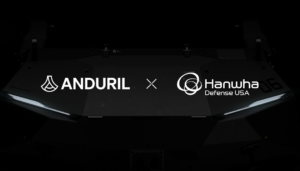Anduril Industries has partnered with Hanwha Defense USA
on a bid for the Army’s Small Multipurpose Equipment Transport (SMET) Inc. II ground robot competition, the companies said on Thursday.
The two firms said they submitted a bid for SMET Inc. II offering a “modified, autonomy-ready” uncrewed ground vehicle based on South Korean defense firm Hanwha’s Arion-SMET platform, and noted their team also includes Clarksburg, Maryland-based Forterra’s AutoDrive vehicle autonomy solution.

“We are thrilled about partnering with Hanwha Defense USA and Forterra to provide mature and proven hardware and software solutions to the S-MET program,” Zach Mears, Anduril’s head of strategy, said in a statement. “By combining Anduril’s electronics and software, Hanwha Defense USA’s proven hardware and Forterra’s proven off-road vehicle autonomy stack, the partnership will bring speed, flexibility and advanced capabilities to dismounted infantry. With a simplified user interface powered by Lattice, users will be able to quickly and easily command and control the S-MET to support lethal effects at the tactical edge.”
SMET Inc. II is the Army’s effort to field the next version of its equipment-carrying ground robot, with plans to pursue new multi-mission payloads for the platform.
General Dynamics [GD] manufactures the Army’s current SMET system after winning a $249 million production deal in July 2020 to deliver ground robots able to carry up payloads of up to 1,000 pounds, or about nine soldiers’ worth of equipment, as well traveling up to 60 miles over the course of 72 hours (Defense Daily, July 15, 2020).
The Army first detailed plans in March 2022 to pursue an open competition for the follow-on SMET Inc. II, which it said may include procuring over 2,000 more robotic platforms (Defense Daily, March 2 2022).
Kyle Bruner, the Army’s project manager for force projection, told attendees at this week’s NDIA Tactical Wheeled Vehicles Conference in Charlotte, North Carolina the service plans to make a prototype award for SMET Inc. II by late fiscal year 2024 or early FY ‘25.
“What you can imagine though is not what that platform brings in terms of just load-carrying capability but all the things that could be integrated onto it, and it can only be limited by the imagination,” Bruner said at the conference. “We are working toward an [SMET] Inc. II to create an open standards architecture so it can be very easy to plug and play all these capabilities the Army wants to add to its robotic system. And that’s what Inc. II brings to the game, in addition to increased power output and increased militarization and hardening.”
Bruner noted the Army is in its last year of fielding the original SMET system with the next version of the platform intended to transition from a tele-operated capability to autonomous operations, as well as handling up to 2,500 pounds of gear and new multi-mission payloads, to potentially include counter-drone capabilities.
An Anduril spokesperson told Defense Daily the team’s offering for SMET Inc. II includes its Lattice software solution that “enables teams of uncrewed systems to work together autonomously,” while Forterra’s AutoDrive vehicle autonomy stack will “manage local vehicle perception, local path planning and controls system management to enable complex on and off-road maneuvers.”
In this case, Lattice will enable Anduril’s S-MET to team and integrate with crewed and uncrewed assets, including other S-METS and [unmanned vehicles], in addition to soldiers operating alongside the vehicle. Those inputs will then be fed into Forterra’s AutoDrive to inform local path planning. From there, AutoDrive will manage the autonomous behaviors of the vehicle,” the Anduril spokesperson said.
Hanwha announced in early January it had recently completed a week-long field test of its Arion-SMET platform with the U.S. Army and Marine Corps, as part of the Pentagon’s Foreign Comparative Testing (FCT) program to assess allies’ capabilities that have a high technology readiness level.
“Arion-SMET’s participation in the U.S. FCT program [is] evidence of its potential success, positioning it as a strong contender in the UGV markets of the U.S. and other countries in the future,” Youngwoo Seo, executive vice president of Hanwha Aerospace’s land systems business group, said in a statement at the time.